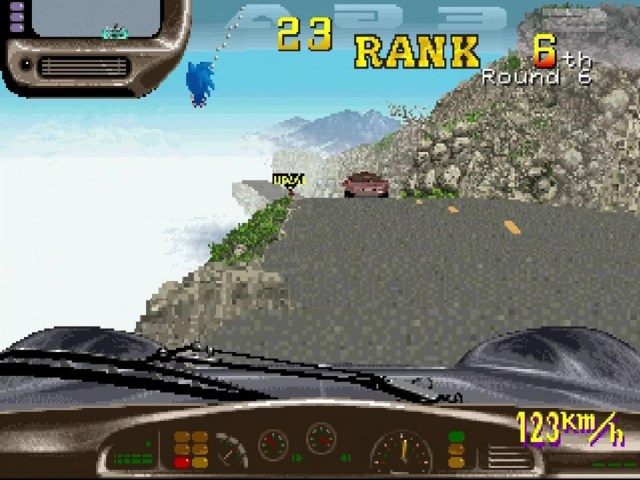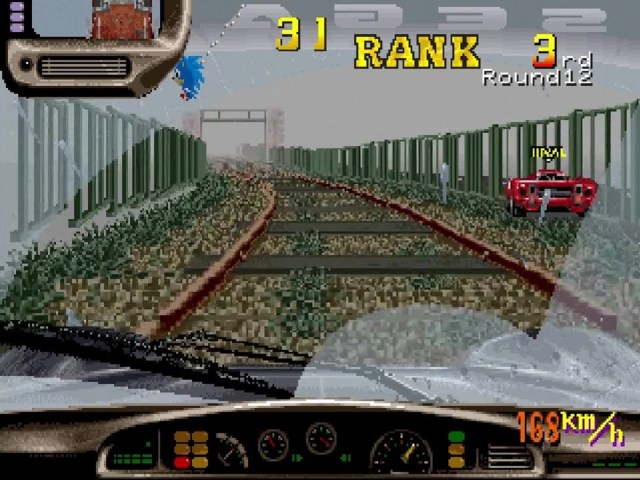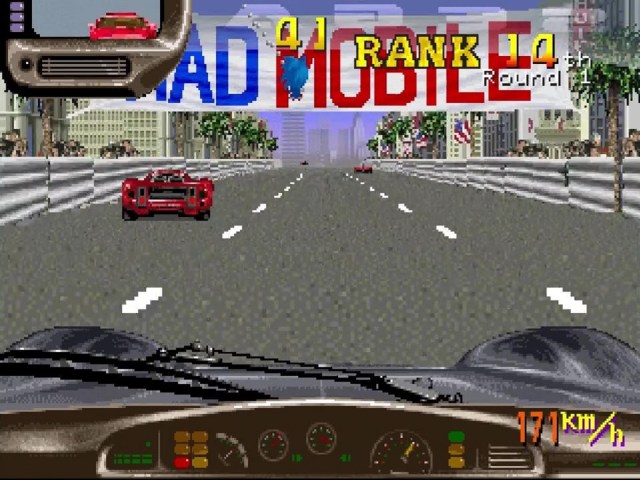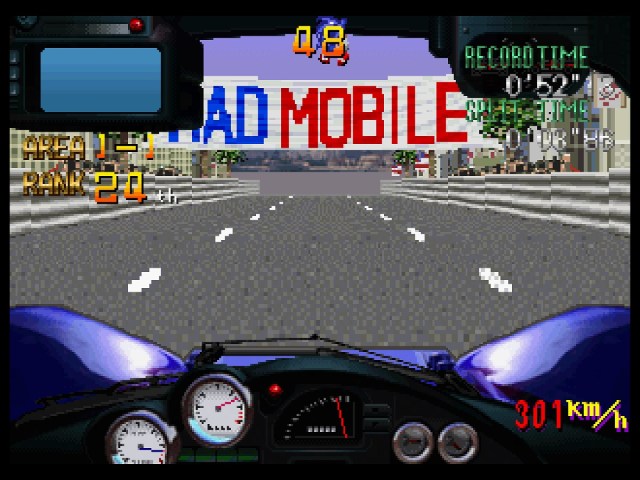Sonic the Hedgehog first appeared in 1990’s Rad Mobile for arcade a few months before the first Sonic the Hedgehog game. He appears as an ornament dangling from the ceiling of the car.
I wanted to get that bit of trivia out of the way because it’s often all anybody knows about Rad Mobile. That is, if they even remember the name. I say that because I could never really remember it. Not until I became interested in pre-3D racing games.
This is mostly because Rad Mobile was only once ported to console and never in North America. That is, until it was chosen as one of the games for the Sega Astro City Mini. That’s still a pretty niche platform in this part of the world, so I’m still waiting for it to finally get the spotlight over here.

That pesky hedgehog
Rad Mobile is interesting to me because it uses the “Super Scaler” pseudo-3D technique that Sega built their hardware around. It’s best remembered for Space Harrier, but it was used in OutRun and Hang-On. However, both OutRun and Hang-On used raster effects for their pseudo-3D road, whereas Rad Mobile just makes heavy use of scaling sprites. This is the same technique used by 1988’s better-remembered Power Drift.
So, rather than your car driving on a background layer or single sprite, you’re actually riding across a steady stream of overlapping sprites that gradually get bigger to simulate parts of the road getting closer to the screen. It’s as obvious as it is effective. Because it was easy to create bridges and hills using Super Scaler, racing games that used the effect typically had a lot of variation in elevation, to the point where they can sometimes feel like roller coasters.
Despite being designed by Yu Suzuki, Rad Mobile is hardly the best racing game of its era. The floatiness of the car and the difficulty in gauging depth with 2D sprites combined with the first-person perspective makes it feel quite janky. However, it still has a lot going for it and I love it all the same.

Are we there yet?
Rad Mobile is your typical story about a race across the United States, from West to East coast. This would also be seen in Turbo OutRun and Cruis’n USA, among others. The journey is separated into 20 short tracks, each depicting a different location. Like many racing games at the time, you have to make each checkpoint within a short time limit to replenish your clock. However, on top of this, you compete against other racers on the same trip. If you’re careful, you can drive across the U.S.A. in less than half an hour, so I’m not sure why planes exist.
I’m not sure that Rad Mobile was ever intended to be played with a digital controller. The Astro City Mini version allows this, but most cabinets I’ve seen have a steering wheel. It’s a Sega System 32 board, so it most likely could have been installed in a real Astro City arcade cabinet, but the car controls are so sluggish and pressing an arcade button to accelerate is so uncomfortable it feels like a racing wheel is necessary. Still, it plays okay with a normal arcade stick.

A long drive for someone with nothing to think about
A lot of Rad Mobile’s appeal comes from the variety it has stretched across the continent. Some tracks play at night, and you have to activate headlights to get a better view of the road. Meanwhile, it rains on others, and a pair of wipers keep your windshield clear. My favorite, however, is one that forces you to drive on train tracks and puts an impending locomotive in your rear-view mirror, threatening to clobber you if you clip a wall.
Speaking of clobber, there are police in some legs of the race. I’m not totally clear on why, but sometimes, if they get ahead of you, they’ll pull you over. Then, a police officer walks up to you and absolutely crushes your (formerly) radical automobile with one punch. It was a weird era in video games where people beat up a lot of cars, I guess.
One of the strangest parts, however, is the Rocky Mountains. If you slip off the edge of the track, you fall through nothingness for a few seconds before the road reappears beneath you and catches your car. It wrecks your car, but it was at least nice of the level to loop back around to give you something to land on.

Scaling for consoles
The Sega Saturn version of Rad Mobile, Gale Racer, is something of a strange conversion. Largely, it’s a pretty reasonable port of the arcade game, but it’s also not as good. Mainly, this is because every track is separated by a loading screen, whereas the arcade version feels like one continuous journey. This not only kills the feeling of long-distance travel, it also eliminates the competitive feel of the game. You still pass cars on your journey, but it seems more like you’re doing it for score rather than to win a race.
Also, your speed tops out at around 300km/h for some reason, compared to the arcade’s 170km/h. You still move at the same clip, the speedometer just reads differently.
The other vehicle are rendered in polygonal 3D, for some reason. The car also handles a lot crappier. There are police vehicles, but I don’t think they can pull you over anymore. The worst part about it, however, is the draw distance. It’s a lot smaller than the arcade version, which I’m guessing is because the Sega Saturn doesn’t have the same dedicated sprite scaling hardware. However, it could also be because it released in 1994, and most games of that time were rushed for the new hardware.
On the other hand, there’s a two-player mode. The soundtrack is a lot better. It’s also interesting that it didn’t come to North America, because it’s entirely in English. There’s even a text crawl at the beginning that is completely in English, but has Japanese subtitles.
Still, Rad Mobile is better than no Rad Mobile.

Sega Arcade Arena
Sega seems to be having trouble figuring out what to do with all its arcade classics. They’ve provided a slow trickle of their best games through series like Sega Ages, but a lot of them are still inaccessible. The Sega Astro City Mini is nice, but it’s expensive and works better as a showpiece than as a mini console.
They need something like Capcom Arcade Stadium. Some sort of bigger compilation of their arcade titles that don’t absolutely need online connectivity. That, or they need to let Hamster dig through their back catalog for the Arcade Archives series. Or something. I just hate having to scour through old ports to try and find specific titles.
Rad Mobile is worth scouring for. It pokes me directly in my love for road trips and appeals to me through its weirdness. Too often, racing games are just monotone and serious. It’s no wonder I just cling to any driving game that offers more than just four wheel and an engine.
For other retro titles you may have missed, click right here!






Published: Aug 25, 2023 04:00 pm